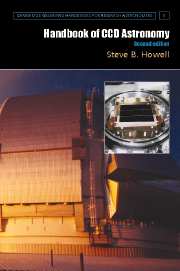Book contents
- Frontmatter
- Contents
- Preface to the first edition
- Preface to the second edition
- 1 Introduction
- 2 CCD manufacturing and operation
- 3 Characterization of charge-coupled devices
- 4 CCD imaging
- 5 Photometry and astrometry
- 6 Spectroscopy with CCDs
- 7 CCDs used in space and at short wavelengths
- Appendices
- References
- Index
Preface to the first edition
Published online by Cambridge University Press: 05 June 2012
- Frontmatter
- Contents
- Preface to the first edition
- Preface to the second edition
- 1 Introduction
- 2 CCD manufacturing and operation
- 3 Characterization of charge-coupled devices
- 4 CCD imaging
- 5 Photometry and astrometry
- 6 Spectroscopy with CCDs
- 7 CCDs used in space and at short wavelengths
- Appendices
- References
- Index
Summary
We are all aware of the amazing astronomical images produced with telescopes these days, particularly those displayed as color representations and shown off on websites and in magazines. For those of us who are observers, we deal with our own amazing images produced during each observing run. Just as spectacular are photometric, astrometric, and spectroscopic results generally receiving less fanfare but often of more astrophysical interest. What all of these results have in common is the fact that behind every good optical image lies a good charge-coupled device.
Charge-coupled devices, or CCDs as we know them, are involved in many aspects of everyday life. Examples include video cameras for home use and those set up to automatically trap speeders on British highways, hospital X-ray imagers and high-speed oscilloscopes, and digital cameras used as quality control monitors. This book discusses these remarkable semiconductor devices and their many applications in modern day astronomy.
Written as an introduction to CCDs for observers using professional or off-the-shelf CCD cameras as well as a reference guide, this volume is aimed at students, novice users, and all the rest of us who wish to learn more of the details of how a CCD operates. Topics include the various types of CCD; the process of data taking and reduction; photometric, astrometric, and spectroscopic methods; and CCD applications outside of the optical band-pass.
- Type
- Chapter
- Information
- Handbook of CCD Astronomy , pp. x - xiiPublisher: Cambridge University PressPrint publication year: 2006



